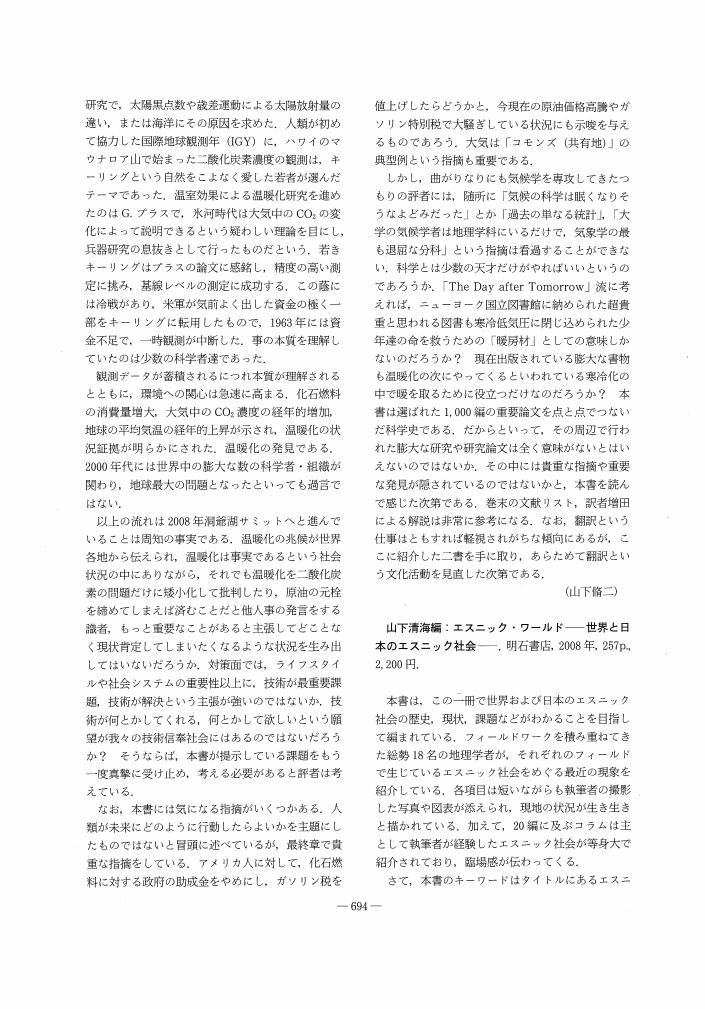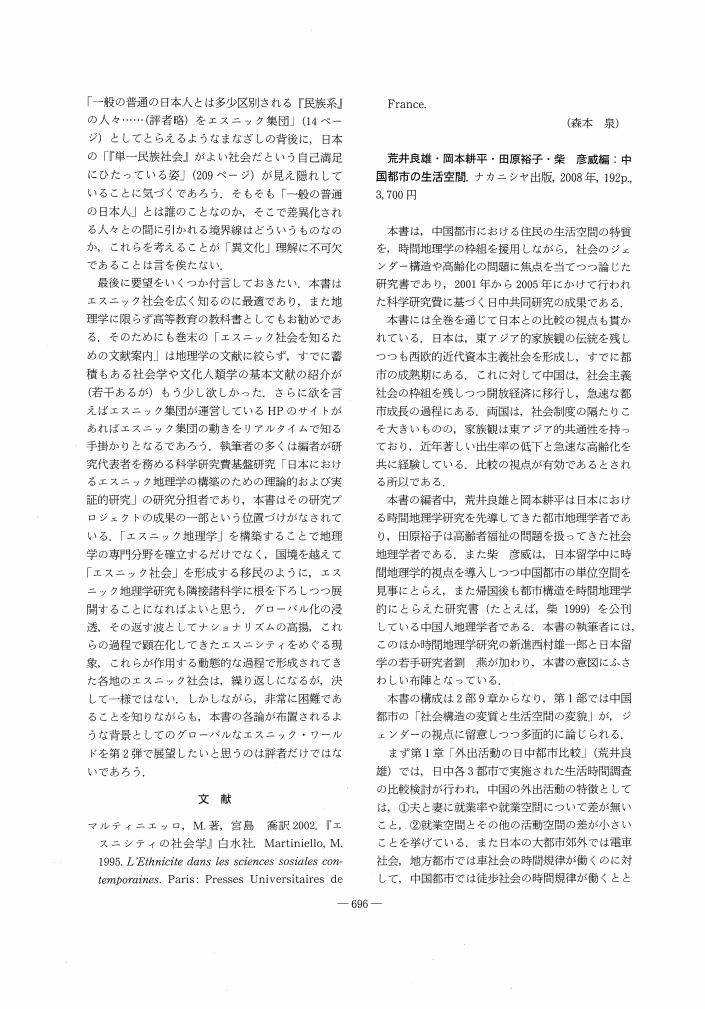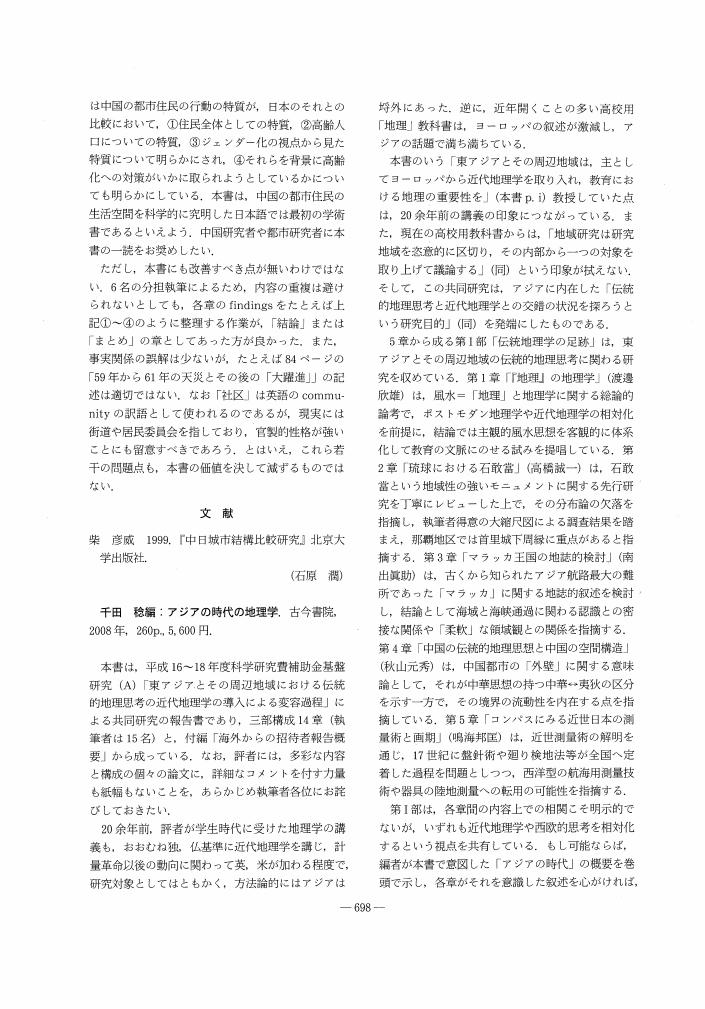1 0 0 0 山城盆地南部低濕地域における平地の發達
- 著者
- 谷岡 武雄
- 出版者
- 公益社団法人 日本地理学会
- 雑誌
- 地理学評論 (ISSN:00167444)
- 巻号頁・発行日
- vol.23, no.11, pp.385-388, 1950
1 0 0 0 東播平野(加古川・明石川流域)の条坊(里)について
- 著者
- 谷岡 武雄 山田 安彦
- 出版者
- 公益社団法人 日本地理学会
- 雑誌
- 地理学評論 (ISSN:00167444)
- 巻号頁・発行日
- vol.27, no.7, pp.275-286, 1954
We have investigated the distribution of the “Jori”-type pattern in the paddy fields, with an intention of examining historically exploitation and reclamation in the eastern Harima Plain, southern part of Hyogo Prefecture. And also this treatise is aimed at the reconstruction of the “Jori”-system as a system of agricultural village planning in ancient times. In this region, a vast area is occupied by the hills of Miocene Series and the uplands of the Plio-Pleistocene Series, the alluvial plain is relatively narrow. Consequently, the development of the exploitation in the plain is not very old and the process was rather slow. In this plain, the “Jori”-type system is not universal and is discontinuous, as seen in Fig. 1-3.<br> The “Jori”-system was a system established in 652 to divide the cultivated land in a mesh of 6-cho squares, (a 6-cho square is equal to about 650 metres square in area.) These squares were called “Sato”. A “Sato”, in turn, was divide dinto 36 equal parts, a part being 1-cho square, this was called a “Tsu.bo”. The allotments of the paddy fields based on the “Jori”-system in Kato -gun (county) have a direction of N 43°E (Fig. 3) along the lengthwise lines. But, in many other areas, the lengthwise lines of the allotments of the paddy fields run about N 18°E or N 22°E, and resemble those in the Shikama-gun (Himeji district), In Taka-gun which is situated along the upper stream of the Kakogawa, the lengthwise lines of the “Jori” pattern run nearly N-S, or approximately N 6°W; the latter is similar to those of the “Jori” pattern in Tajima and Tamba areas (northern part of Hyogo Prefecture).<br> In the eastern Harima plain, the distribution of the “Jori”-type pattern is limited to the valleys which have had no recent inundation or to the older deltas. In the valley plains, the older settlements have been located at the foot of the uplands. But, the “Jori” pattern is not found in mountainous districts, hilly lands, uplands flood plains and the newer deltas.<br> On the delta of the Kakogawa, the “Jori” -system exists in the areas more than 2 kilometers inland from the coast line. But, on the delta of the Akashigawa, it is found also in the areas near the coast line.<br> We have tried to reconstruct the site of the “Joel”-system, the ancient administrative system, in Kako-gun (Fig. 2.) and Akashi-gun (Fig. 3.), basing the reconstruction on the lots, place names, cadastral maps and ancient documents. In these two counties, the east-west line of “Sato” of the “Jori” pattern which divided the cultivated lands into 6-cho squares was called the “Bo”, and the north-south line was called the “Jo”, the former counting from the southern border line to the northern, the latter counting from the western border line to the eastern. This system, in this province, was called the “Jobo”, but in other provinces, was called the “Jori”.<br> In these areas, the cadastral number in the “Jori”-system makes a continuous series, that is, from the south-eastern corner to the south-western corner, next, from the west to the east and so on, thus to arrive at the north-eastern corner.
1 0 0 0 東大寺領水沼庄の歴史地理学的研究
- 著者
- 谷岡 武雄 平野 健二 芦田 忠司 田中 欣治 井上 淳
- 出版者
- 公益社団法人 日本地理学会
- 雑誌
- 地理学評論 (ISSN:00167444)
- 巻号頁・発行日
- vol.31, no.4, pp.191-205, 1958
One of the oldest cadastral maps (drawn in 751 A. D.) kept by Shosoin, is that of the Minuma manor in Omi province of the Todai-ji temple. It shows the “Joni”-system which was the land system of ancient Japan. As result of our research on the “Jori”-system of Inukami county in Omi, it was proved that the area in the map corresponds to the domain of the modern village, Binmanji, in the east of Hikone City. We made a general and intensive survey by means of reading air photographs, land measurements, soil analysis, studying old documents and archeological excavation of the domain of the manor. The results are as follows:<br> 1) The Minuma manor belonging to the Todai-ji temple occupied the Inukami river's fan in the middle of the lake Biwa plain about the middle of the 8 th century. Inspite of fierce overflows at heavy rains, it was neccessary first of all to built a reservior and an irrigation canal for the management of paddy fields, because the ordinary quantity of water supplied by the river was insufficient and the soils of this fan was osmotic.<br> 2) Below the soils now under cultivation, there spreads the stratum of the anciently cultivated soils and it is probably the same stratum as the one containing the remains which are supposed to be belong to 8th century.<br> 3) Judging from the roads the reservoir, some parts of land division and the black coloured soils found by excavation, we think that the “Jori”-system was put in operation over this area to the same direction as the other parts of Inukami county.<br> 4) The land division in most parts of lands now under cultivation is very much different from the “Jori”-system in Inukami county, and it is adapted to the land form.<br> 5) It is better to consider that the Todai-ji manor has occupied this area based on the “Jori”-system. But there are some differences between the old lands of the manor and the present ones. The reasons would probably be due to the overflows or changes of various human geographical conditions.<br> 6) The history of the settlements of this area began in Nara era, at the establishment of this manor.<br> 7) The houses which occupied the hilly land consisting of the old aluvial strata, remained for considerably long period. And the houses which were situated on the flood plain of the river seem to have been lost by overflows and lateral erosion of the Inukami.<br> 8) The site of the present village seems to correspond to Shibahara (brush fields) on the map, and the village has the character of a “Monzen-Machi” of the Binman-ji temple which was built up in Heian era. Probably the movements of the residents from hilly land to the present site were done gradually over the long period before Meiji revolution.<br> 9) Considering the land from, the land system and the result of the archeological excavation, we conclude that contents of the map was not so different from facts.<br> 10) And so we can say that the Todai-ji manor in this area was established not through the acquirement of already cultivated lands, but through the clearing of lands which were hard to cultivate. In this, we recognize the peculiar character of the Todai-ji manor in Nara era, and this character was common the other manors of this temple.
1 0 0 0 アイセル湖ポルダーにおける集落配置計画と中心地理論
- 著者
- 杉浦 芳夫
- 出版者
- 公益社団法人 日本地理学会
- 雑誌
- 地理学評論 (ISSN:13479555)
- 巻号頁・発行日
- vol.79, no.11, pp.566-587, 2006-10-01
- 参考文献数
- 84
- 被引用文献数
- 1 3
本稿では,オランダのアイセル湖ポルダ-における集落配置計画と中心地理論との関係を,文献研究を通して考察した.四つの干拓地のうち,当初の集落配置プランに中心地理論がヒントを与えた可能性があるのは北東ポルダーであり,その場合,形態論的側面にだけ限定すれば, Howard(1898)の田園都市論を媒介にしている可能性がある.東フレーフォラントと南フレーフォラントについては,上位ランクの集落配置は,考え方の点で,明らかに中心地理論の影響を受けているTakes(1948)の研究『本土と干拓地の人ロ中心』に基づいてなされた.東フレーフォラントの下位ランクの集落配置については,都市的生活を指向し,車社会に移行しつつあった当時のオランダ農村事情に通じていた社会地理学者らめ意見に基づき,中心地理論が厳密に応用されることなく行われた.ポルダー関連事業で活躍したこれらオランダの社会地耀学者の調査研究成果は,中心地理論研究史の中でも評価されて然るべき内容のものである.
1 0 0 0 OA 名古屋市の地理的空間とメンタルマップ
- 著者
- 中村 豊
- 出版者
- The Association of Japanese Geographers
- 雑誌
- 地理学評論 (ISSN:00167444)
- 巻号頁・発行日
- vol.51, no.1, pp.1-21, 1978-01-01 (Released:2008-12-24)
- 参考文献数
- 25
- 被引用文献数
- 7 3
近年,わが国でも,メンタルマップに対する関心が寄せられているにもかかわらず,実証的な研究はほとんどなされてこなかった.そこで,筆者はわが国における都市域のメンタルマップの名古屋市における事例研究を行なった.都市域のメンタルマップについては,リンチLynchのエレメント抽出以後も,地理学においてはほとんどなされなかったが,1960年代後半にアダムスAdamsがくさび形のメンタルマップの仮説を示すことにより,1つの議論の材料が与えられた。しかし,アダムスの仮説は実際のメンタルマップを説明するには不十分であったので,それは再検討をせまられた.再検討の方向は,1つにはアダムスの仮説を,分析方法を洗練させることによって修正するものであり,もう1つはメンタルマップの操作的な概念の変更であった.本研究では,筆者はこの2つの方向に従って実証的に両者を比較検討した.その結果,アダムスの仮説は概念化が不十分であり,メンタルマップの概念化は行動的アプローチを基礎に行なわれる方がよいことが理解された.そして,その行動的アプローチによって,都市域のメンタルマップはより一貫した説明が可能になることが理解された.
1 0 0 0 本邦地理学界における都市化研究の現段階
- 著者
- 石水 照雄
- 出版者
- 公益社団法人 日本地理学会
- 雑誌
- 地理学評論 (ISSN:00167444)
- 巻号頁・発行日
- vol.35, no.8, pp.362-373, 1962
- 被引用文献数
- 2
本稿は本邦においてとくに近年多くの関心が注がれている都市化の問題に関してなされた諸研究の成果を整理し,体系化を試みることによつて,この分野における地理学的研究の現段階(水準)を認識し,今後の研究の方向について若干の考察を行なうことを目的とする. (1) 本邦地理学界の都市化に対する関心がとくに高まつたのは戦後であるが,これは戦後における激しい都市化現象の進展に対応している. (2) 都市化概念については,いくつかの見解が披渥されたが,景観に重点をおく狭義の見解と機能に重点をおく広義の見解とに分れている. (3) 都市化のメカニズムに関する理論化に多くの努力が払われてきているが,現段階では都市化現象のecological processの分析を通じて都市化の空間的・地域的機構を求める方向に進んでいる. (4) 本邦における都市化の特質を明らかにするため,京浜・阪神・中京・東北の各地方ならびに本邦全体に関して,都市化の諸段階・近郊地域相互の比較・地域としての特色などについての研究がなされてきている. (5) 今後の都市化研究のあり方については,空間的・地域的観点が強調されecological approachに対する支持が大きく,また社会的貢献のためにも都市化地域理論が要請されている. (6) これらの文献研究を通じて結論されることは,現在の方向に沿うより多くの事例研究の必要性である.
1 0 0 0 OA 大井川上流域におげる村持林野の成立
- 著者
- 藤田 佳久
- 出版者
- The Association of Japanese Geographers
- 雑誌
- 地理学評論 (ISSN:00167444)
- 巻号頁・発行日
- vol.41, no.5, pp.297-309, 1968-05-01 (Released:2008-12-24)
- 参考文献数
- 23
わが国における林野所有形態の地域差に関連し,大井川上流域旧田代村(現井川村の北部)の明治初期官民有区分時の土地台帳の変化を通じ村持林野成立の要因を把握しようとした.その結果,水田を欠き焼畑が生活基盤であったこの村では旧天領であったことも関連し,農民層分解がみられず自作農民からなっていたこと,それゆえ総有的な奥山林野が村側の名目的個人分割化の対応もふくみながら一括村持山として認定されたことが認められた.このような山間焼畑地域における地域的性格は官民有区分に大きな意味をもったと思われる.
1 0 0 0 OA 富士山の地名学的研究
- 著者
- 鏡味 完二
- 出版者
- The Association of Japanese Geographers
- 雑誌
- 地理学評論 (ISSN:00167444)
- 巻号頁・発行日
- vol.28, no.5, pp.237-248, 1955-05-01 (Released:2008-12-24)
- 参考文献数
- 32
Bis heute ist der Wortsinn des Berges “Fuzi”, Fudschi-jama auf Deutsch, von vielen Gelehrten erklirt worden durch ein Aino Wort “Huchi” (=die Grossmutter, die Göttin des Feuers). Aber Dr. K. Kindaiti bewies, dass die Auslegung ein Missverständnis war. Doch es gibt hieriiber noch keinen treffenden Aufschluss in der N issenschaftlichen Welt. Hierauf land der: Verfasser überzeugende Beweise, dass das Wort “Fuzi”, ein altes echt japanisehes Wort ist, das die Schönheit der langen Abdachung des Berges bedeutet. (1) Auf Japanischen Inseln gibt es den Dialekt “Fuzi” welehes die lange Abdachung des Berges bedeutet. Auch der Regenbogen und die Glyzinie, die sehön in der Luft hängen, werden noch jetzt im Dialekt als “Fuzi” bezeichhnet. (2) Die vielen Ortsnamen “-fuzi”, deren Ursprünge die wie obenstehende Bogengestalten sind, verbreiten sick auf den Japanischen Inseln. (Siehe Abb. I). (3) Der Verbreitungstypus der Ortsnamen von “fuzi” hat eine Struktur der konzentrischen Kreise, deren Zentrum sick in Yamato befindet. Es g_??_bt keine Beziehung zwischen dem Gebiete der, Verbreitung und Hokkaido als Heimat der Aino. Der Verfasser ermittelte auch, dass die Ortsnamen “-fuzi” nicht so alt sind, wie bis heute von vielen Gelebrten angenommen wilyde; nämlich die Namen der Berge “-fuzi” kamen in der Zeit vom 3. _??_7. Jahrhundert vor, und die der vielen Siedlungen “-fuzi” (Siehe Abb. 1) im 9. J. H.. Die Verbreitung des Namens “Fuzi-san” (-san=-yama=Gebirge) mit dem Namen “Asalma- yama” (“Asama” stammt von “Azama” =Name des Seevolkes in alter Zeit) entsprechen der Entw icklungsregion der Berg-religion von “Fuzi-sengen” (“-sengen” ist die Japanische Farallele des chineschischen Zeichens “Asama”). Der Zasanlmenhang zwischen dem beiden Verbreitungen von Berg und Religion bedeutet, dass diese Bergreligion sich im Gesichtsfeld von “Fuzi-san” entwickelt hat. Das Gesichtsfeld von “Fuzi-san” ist ebenso ausdehnbar, wie die Kreisflache mit dem Halbmesser von 223 KM. (Siehe Abb. 3). Auch die Name “Fuzimi” (Von aus kann man den “Fuzi-san” sehen) verbreiten sich in diesem Kreise (Siehe Abb. 4). Abb. 1: Verbreitung der Namen “Fuzi”, die die lange Abdachung des Berges bedeuten. Abb. 2: Verbreitung der Namen “Azumi”, “Azuma” and “Asama”. Diese N amen sind für Berge and Siedlungen. “Azwni” ist der älteste. “Azuma” and “Asama” folgen nach “Azumi. Diese stammers von Seevolksnamen. Abb. 3: “Fuzi” and “Asama” -Bergnamen Zeichen des Hiihnerauges ist “Fuzi-san”. Kleine Kreise sind Namen des Berges “Fuzi”, schwarze Punkte sind Namen des Berges “Asalma-yama”. Abb. 4: Verbreitung des Namens “Fuzimi” “Fuzimi”. bedeutet, dass von -aus man den “Fuzi-san” sehen kann.
- 著者
- 滝波 章弘
- 出版者
- 公益社団法人 日本地理学会
- 雑誌
- 地理学評論 (ISSN:13479555)
- 巻号頁・発行日
- vol.76, no.9, pp.621-644, 2003
- 被引用文献数
- 2
本稿は,都市のホテルにおける雰囲気について,空間的な議論を試みたものである.従来の研究は雰囲気を商品や情感として実態的に扱ってきたが,本稿では雰囲気を空間的かつ社会的に構成されるものと考え,その意味を考察した.すなわち事例として,ホテル産業が大きな位置を占めるジュネーブ市街地の著名なホテルを取り上げ,雰囲気を提示することがホテルの当事者にとってどのような意味を持つかを,ホテル関係者のコメントを中心に,ホテルのパンフレット,ホテル編集の雑誌,ホテルの空間構造などを参照しながら分析した.その結果,ホテルにおける雰囲気は,単なる場所の状態ではなく,ホテル側の戦略に基づき,ホテルという場所を,フランス語圏地理学でいうような領域とする役割を持つものとして意識されていることが明らかになった.
1 0 0 0 ニュージーランド北島北東岸の海成段丘と地殻変動
- 著者
- 吉川 虎雄 太田 陽子 米倉 伸之 岡田 篤正 磯 望
- 出版者
- 公益社団法人 日本地理学会
- 雑誌
- 地理学評論 (ISSN:00167444)
- 巻号頁・発行日
- vol.53, no.4, pp.238-262, 1980
- 被引用文献数
- 44
ケルマデック諸島南端部に近いニュージーランド北島プレンティ湾南東岸地域の海成段丘は,上位からマタカオア・オタマロア・テパパ・テアラロアの4段丘に分類される.これらの各段丘は,いずれも海進を示す地形と堆積物とを伴い, 4回の高海面期の存在を示す.段丘をおおうテフラの細分とそれらのフィッション=トラック年代,段丘堆積物の14C年代から,段丘の形成期は,上位のものからそれぞれ約22~23万年前,約12~13万年前,約8~10万年前,約4,000~5,000年前と推定される.<br> 各段丘面の高度分布から,この地域では, (1) 南東から北西への傾動と, (2) 北縁部における北への著しい擁曲とが認められる. (1) は,明瞭な二つのヒンジによって, (1a) 南東部の急な傾動, (1b) 中央部のゆるやかな傾動,および (1c) 北西部の沈降とに分かれる. (1b), (1c) および (2) は,この地域の山地の成長を示すが, (1a)は山地地形とは調和しない.段丘面は古いものほど同じ様式でより著しく変位しているので,第四紀後期には各地域ごとに同じ様式の地殻変動が継続したことを示す. (1a)の隆起や傾動の規模および速さは,ニュージーランドでは最大級の値であり,環太平洋地域の他の島弧一海溝系におけるそれらに匹敵する.このことと,この地域の海溝に対する位置関係から, (1a)はケルマデック海溝内縁に発生する大地震に伴う地殻変動によるものと考えられる.
1 0 0 0 山崎直方先生と変動地形の研究
- 著者
- 吉川 虎雄
- 出版者
- 公益社団法人 日本地理学会
- 雑誌
- 地理学評論 (ISSN:00167444)
- 巻号頁・発行日
- vol.44, no.8, pp.552-564, 1971
- 被引用文献数
- 3
大地震の際におこった地殻変動の調査から生れた山崎直方先生の変動地形観は,その後の研究に大きな影響を与え,変動地形の研究はわが国の地形研究における一つの大きな柱として発展した.先生の変動地形観は,その後の研究によって改められるべき点も生じてきたが,基本的には正しいことが明らかになってきた.わが国における変動地形の研究は,現在ようやく山崎先生の意図しておられた段階に到達し,最近いちじるしい進展のみられる固体地球科学との連契を一層深めて,新しい段階に入るべき時期を迎えている.<br> 本稿では,変動地形について山崎先生が抱いておられた見解の中で,とくに現在の地殻変動と地形発達に関与した過去の地殻変動との関係についてのその後の研究の進展をのべ,地形構造の研究において今後とるべき一つの方向を論じた.
1 0 0 0 OA 名古屋市における認知距離
- 著者
- 岡本 耕平
- 出版者
- The Association of Japanese Geographers
- 雑誌
- 地理学評論 (ISSN:00167444)
- 巻号頁・発行日
- vol.56, no.10, pp.695-712, 1983-10-01 (Released:2008-12-24)
- 参考文献数
- 18
- 被引用文献数
- 8 2
本稿の目的は,名古屋市における認知距離をできるだけ多様な角度から検討することによって,研究方法の違いを越えて認められる認知距離の基本的性質を明らかにすることである.分析の結果,認知距離を規定する要因は,被験者の属性より,むしろ起点(被験者の位置),終点,認知される距離の種類などの刺激中心要因群であることがわかった.刺激中心要因群は,都市構造と関係するr本研究では特に,起点を複数選定し,しかも直線距離と時間距離の認知形態を比較した結果,名古屋市の都市構造が認知距離に及ぼす影響を見い出した.また名古屋市では,都心方向への距離は,都市縁辺方向への距離に比べて過小評価され, Lee (1970) の結果を支持した.
1 0 0 0 OA インドネシアの降水量分布と気流系
- 著者
- 江口 卓
- 出版者
- The Association of Japanese Geographers
- 雑誌
- 地理学評論 (ISSN:00167444)
- 巻号頁・発行日
- vol.56, no.3, pp.151-170, 1983-03-01 (Released:2008-12-24)
- 参考文献数
- 37
- 被引用文献数
- 9 10
本稿は,インドネシアの降水分布を規定している要因を明らかにすることを目的とした.インドネシアの気流系は,主として北太平洋起源の熱帯東風南太平洋起源の熱帯東風インド洋起源の西風という3つの気流によって構成されている.多降水域は,熱帯収束帯とは必ずしも一致せず,インド洋起源の西風帯内に出現している.また,多雲量域もこの西風帯内に分布し,インド洋起源の西風がインドネシアの降水分布を規定する要因となっている.そのため熱帯収束帯は,多降水域や多雲量域の及ぶ限界としてとらえられる.熱帯東風の卓越する地域では,一般に降水量,雲量とも少ない.特に,南太平洋起源の熱帯東風の卓越する地域では,降水量,雲量とも少ない.
1 0 0 0 OA 渡辺理絵: 近世武家地の住民と屋敷管理
- 著者
- 溝口 常俊
- 出版者
- The Association of Japanese Geographers
- 雑誌
- 地理学評論 (ISSN:13479555)
- 巻号頁・発行日
- vol.81, no.8, pp.689-690, 2008-11-01 (Released:2010-03-12)
1 0 0 0 OA 植木岳雪・酒井彰: 青梅地域の地質, 地域地質研究報告 (5万分の1地質図幅)
- 著者
- 久保 純子
- 出版者
- The Association of Japanese Geographers
- 雑誌
- 地理学評論 (ISSN:13479555)
- 巻号頁・発行日
- vol.81, no.8, pp.691-692, 2008-11-01 (Released:2010-03-12)
- 参考文献数
- 5
- 著者
- 山下 脩二
- 出版者
- The Association of Japanese Geographers
- 雑誌
- 地理学評論 (ISSN:13479555)
- 巻号頁・発行日
- vol.81, no.8, pp.692-694, 2008-11-01 (Released:2010-03-12)
1 0 0 0 OA 山下清海編: エスニック・ワールド -世界と日本のエスニック社会-
- 著者
- 森本 泉
- 出版者
- The Association of Japanese Geographers
- 雑誌
- 地理学評論 (ISSN:13479555)
- 巻号頁・発行日
- vol.81, no.8, pp.694-696, 2008-11-01 (Released:2010-03-12)
- 参考文献数
- 1
1 0 0 0 OA 荒井良雄・岡本耕平・田原裕子・柴彦威編: 中国都市の生活空間
- 著者
- 石原 潤
- 出版者
- The Association of Japanese Geographers
- 雑誌
- 地理学評論 (ISSN:13479555)
- 巻号頁・発行日
- vol.81, no.8, pp.696-698, 2008-11-01 (Released:2010-03-12)
- 参考文献数
- 1
1 0 0 0 OA 千田稔編: アジアの時代の地理学
- 著者
- 三木 理史
- 出版者
- The Association of Japanese Geographers
- 雑誌
- 地理学評論 (ISSN:13479555)
- 巻号頁・発行日
- vol.81, no.8, pp.698-699, 2008-11-01 (Released:2010-03-12)
1 0 0 0 OA 石川義孝編著: 人口減少と地域 -地理学的アプローチ-
- 著者
- 高橋 眞一
- 出版者
- The Association of Japanese Geographers
- 雑誌
- 地理学評論 (ISSN:13479555)
- 巻号頁・発行日
- vol.81, no.7, pp.604-605, 2008-09-01 (Released:2010-03-12)






